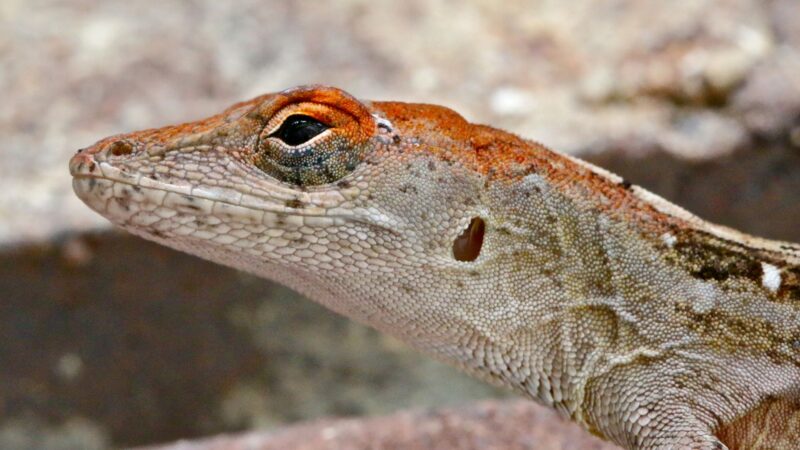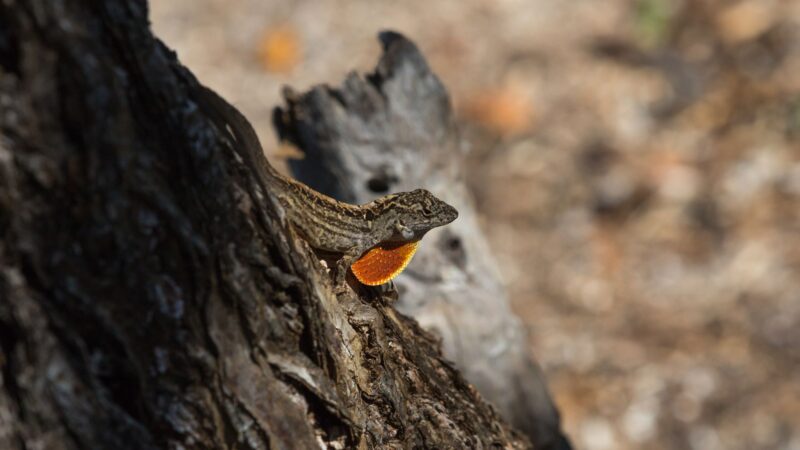Brown anole lizards are not a common sight in homes compared to other lizard species. But they may definitely still become nuisances if left undealt with, especially in states where they are nonnatives.
Here’s how to get rid of brown anole lizards naturally: examine ornamental plants and remove any lizards attached to them, establish lizard traps, modify your property by reducing vegetation and insects, use natural repellents, or contact pest control services for severe infestations.
If you want to know more about brown anole lizards, how to properly identify them, and preventing them from ever coming back, read further for more!
What Are Brown Anole Lizards?

Known as trunk-ground reptiles, Brown Anoles (Anolis sagrei) are medium-sized lizards characterized by their short and broad head, scaly body, short snout, and long tail.
They are varying shades of brown, gray, or black with yellow or white color back patterns. Males have a white-edged, red or orange throat fan while females have a distinctive white stripe and dark triangle pattern on their dorsal side.
Like geckos and skinks, brown anole lizards have long toes with sticky toepads made for strongly gripping to nearly any kind of surface—regardless if it’s smooth or textured.
What Do Brown Anole Lizards Eat?
Brown anoles eat a wide variety of spiders, insects, and other invertebrates. Common food items are crickets, grasshoppers, and flies. They also consume small vertebrates.
Related: What Do Backyard Lizards Eat? | Information and Facts
Where Do Brown Anole Lizards Live?
These lizards are native to Cuba, the Bahamas, and the Caribbean. However, they were unintentionally introduced in southeastern states such as Georgia and Florida.
Brown anoles prefer living in areas characterized by open vegetation or moist forests. They thrive in semi-tropical environments and form territories along trees, vines, shrubs, and fences.
How Big Do Brown Anole Lizards Get?
On average, the snout-to-vent length of adult brown anole males are 54 millimeters with a weight of 6 to 8 grams. Adult females, on the other hand, are 43 millimeters long and weigh 3 to 4 grams.
How Long Do Brown Anole Lizards Live?
Brown anoles live up to 4 to 5 years in the wild and 8 years when kept in human care.
Why Do Brown Anole Lizards Turn Brown?
They change their skin color due to hormonal changes or as a response to external factors. This includes changes in humidity and temperature.
Take note that they are not able to turn themselves green. Only light or dark shades of brown.
Related: How to Get Rid of Alligators | Safety Measures and Removal Methods
Signs of Brown Anole Lizards Infestation

Look for these telltale signs that there are lizards in or around your homes:
- Frequent sightings of small, fast-moving brown lizards
- Droppings that look like small black pellets with a white on the tip
- Lizard eggs found on areas in the house or around plants
Why Do I Have Brown Anoles in My Yard/House?
If you’re wondering why these creepy crawlies are invading your property, here are some of the probable reasons:
- Abundance of food sources or, in other words, insects
- Water found from leaking pipes, kitchen sinks, or small garden ponds also attract them
- Plenty of hiding spots or areas where they can live in
Are Brown Anoles invasive?
Yes, specifically in areas where they were introduced. Brown anoles can become extremely territorial during the breeding season, which can affect other lizard species.
According to wildlife experts from the University of Florida, they don’t cause any declines in the population of other anole species. However, they may still compete with them for food and shelter.
Do Brown Anole Lizards Attack Humans?
No, brown anoles are not known to attack humans but they may still be a nuisance nonetheless. They are small and are great climbers, making them agile invaders of storage sheds, homes, screened rooms, and garages.
What Attracts Lizards in the House and Yard?

Always keep in mind that there are three basic things lizards will look out for in your house or yard: food, water, and hiding spots. If your property has all three—all the more better for brown anole lizards!
How to Inspect for Brown Anole Lizards
Check potential hiding spots. These include any dark, enclosed spaces that the brown anole lizards can fit into such as under furniture, in bookshelves, and even behind potted plants.
Also keep an eye out for places where there are plenty of insects as they may naturally flock to these areas.
How to Get Rid of Brown Anoles Lizards Naturally?
Getting rid of brown anoles doesn’t necessarily require elaborate methods. Here are some strategies you can employ:
- Examine ornamental plants: When transporting out plants or receiving them after having them shipped, perform a thorough expectation and remove any brown anoles.
- Establish traps: Use a funnel trap to capture brown anoles in places where they would likely visit. Once the lizard is inside, relocate them in a faraway area.
- Modify your yard or lawn: To make these areas look less suitable for brown anoles to live in, reduce vegetation height and density. This reduces the availability of insects and other invertebrate food sources for the lizards.
- Control insect populations: Apply mechanical (e.g. directly removing or killing), chemical (i.e., pesticides), or cultural (e.g. crop rotation) methods when necessary.
- Use natural repellents: Create a concoction of ingredients that lizards hate, namely: pepper, hot sauce, or cayenne. Mix these with warm water, pour inside a spray bottle, and spray at access points.
- Contact local professional pest control services: If the methods mentioned above prove to be unsuccessful at getting rid of brown anoles, it’s time to call in the experts.
Related: 9 Best Lizard Repellents That Actually Work | A Detailed Guide
How to Catch a Brown Anole Lizard?
It is rather a difficult feat to do so as they are small and speedy. But if you have the patience, wear protective gloves first and foremost.
Brown anoles, like all other lizards, startle quite easily so approaching them with utmost caution should be observed. Make sure they are cornered as well so they cannot escape.
Use a net or broom to capture the lizard then carefully place them inside a container. Once they are successfully caught, find a good place to relocate them, preferably somewhere far away from the vicinity.
How to Prevent Lizards From Invading Property?
You know what they say: prevention is better than cure. In this case, after getting rid of brown anoles, it is important to lizard-proof your property to keep them from coming back.
Here are ways you can do so:
- Seal all entry points that are ¼-inch or larger. Use caulk, insulating foam, steel wool or any other suitable material to close these gaps. Door sweeps and window screens can also be installed.
- Observe good sanitation so that you can reduce the number of potential hiding spots. Sweep under furniture and make sure there is no spilled food or water around your house.
- Maintain plants, trees, shrubbery, and other vegetation. They should not be too tall or else they can provide living areas for the lizards.
Related: How To Get Rid of Lizards in Your House and Around the Yard Without Killing Them
List of Sources
Casanova, L. (n.d.). Norops sagrei: Cuban brown anole, Brown anole.
Dunning, S. (2017). NISAW 2017: Cuban Anole.
Gibbons, W. (2021). Why Do Some Lizards Change Colors?
Johnson, S. A., Reyes, C., Dodge, B., & Claunch, N. M. (2021). Florida’s Introduced Reptiles: Brown Anole (Anolis sagrei).
Mahr, D. (2008). General Approaches to Insect Control.
- How to Get Rid of Copperheads | Practical Guide - August 27, 2023
- How to Get Rid of Corn Snakes | What Makes Them Aggressive? - August 27, 2023
- How to Get Rid of Alligators | Safety Measures and Removal Methods - July 16, 2023
